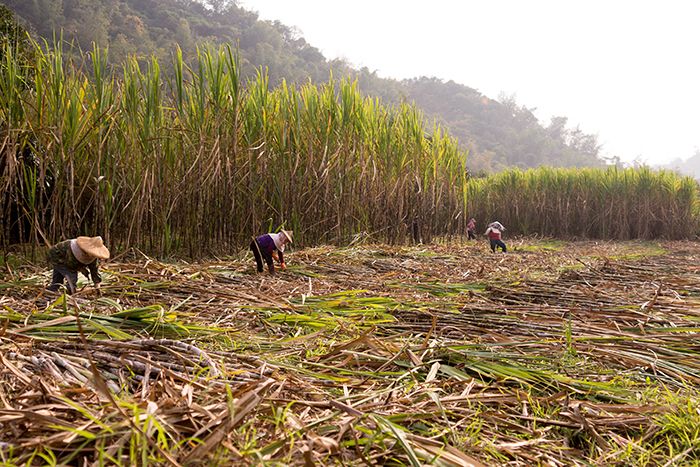
滷味的甜與香:從南方的蔗糖,到北方的麥芽糖
周端政|文化系統觀察者、樸活創辦人
Nelson Chou | Systemic Observer of Culture & Founder of Puhofield
一鍋滷肉,不只是料理;它是糖與香料在東亞大地上的旅行記。
A pot of braised pork is not just cooking — it’s the travel diary of sugar and spice across East Asia.
一、南方的陽光:糖與香料的出海
滷味,其實是一種地理現象。它的氣味屬於風。那股風從閩南、潮汕吹起,經呂宋、馬六甲,飄向南洋群島。
南方的滷汁,是用蔗糖熬成的時間。《嶺南雜記》記載:「糖田千頃,蔗種如竹。」到了明清,廣東、福建、海南成為中國糖業重鎮。
香料則是海上貿易的贈禮。《諸蕃志》說:「自泉、漳、潮、廣南出海,取胡椒、蘇木、丁香諸香。」八角、桂皮、月桂葉從熱帶船艙被帶回中華廚房,與糖結盟,於是有了「紅燒」與「滷」的語法。
糖給了時間的深度,香料給了空氣的形狀。南方的滷肉,就是陽光與海風交會的味道。
二、蔗糖與椰糖:熱帶的甜
南方的甜不止一種。閩南、臺灣習慣用黑糖——那是甘蔗的初煉味,焦香裡帶青草氣。菲律賓的 Pata Tim、馬來西亞的 Humba、印尼的 Semur 都承襲這股蔗糖滷法。
再往赤道,甘蔗遇上了椰樹。當地人以椰花汁煮成棕櫚糖(椰糖),比蔗糖更厚、更香、更帶果脂氣。於是滷汁開始有了熱帶層次:鹹中帶甜,甜中帶香。椰糖讓滷汁不只「焦亮」,而是「柔亮」——像午後陽光在海面上的波紋。
三、香料的航線:從南風入中原
八角、桂皮、月桂葉在南方是日常,在北方卻稀罕。《宋史·食貨志》載:「胡椒、蘇木自南海入廣州。」明代《本草綱目》始將八角茴香列為藥食兩用。香料的旅行,也是氣候的分界:南方潮濕需香防腐;北方乾冷倚重鹽與醬。
南方的香是主角,北方的香是旁白。
四、北方的堅實:鹽、醬與麥芽糖
當蔗糖止步於秦嶺—淮河以南,北方人便自己造糖。《齊民要術》卷八〈造飴法〉記:「以麥芽煎煮為糖,味甘而潤。」這便是麥芽糖——一種以穀物時間換來的甜。它沒有蔗糖的香氣,卻有深沉的焦潤;滷肉、燒雞、紅燒魚,都靠這一口麥芽糖上色收汁。
南方的糖,是植物的陽光;北方的糖,是穀物的時間。
五、日本:蔗糖的柔光
日本的甜味史,正好是一部糖的傳記。《延喜式》記「造味鹽、造醬、造酒」,顯示平安時期已承唐代醬造技術。糖真正普及,則在江戶時代——從琉球與福建輸入的「唐砂糖」進入市井。
砂糖與醬油結合,誕生了照燒(Teriyaki);「照」指的就是糖熬出的光。長崎華僑也帶入福建紅燒技法,發展出豚角煮(Buta Kakuni)——以砂糖、醬油、清酒、薑慢火滷煮,幾乎就是日式 Pata Tim。柳宗悅曾說:「照燒之光,乃砂糖文化的象徵。」
六、韓國:果甜與醬的堅持
朝鮮半島不產甘蔗,糖歷來昂貴。《朝鮮王朝實錄》屢記「唐糖」為貢品。於是形成「以果代糖」的滷法:以梨汁、蘋果泥、麥芽糖提甜。《閨閤叢書》載:「梨汁煮肉以代糖味。」代表作如 Jangjorim(醬煮牛肉) 與 Galbijjim(紅燒排骨),靠醬油、蒜、果甜與少量麥芽糖平衡鹹甜。韓國的甜不焦不厚,而是清爽透明——像風裡的一抹果香,讓鹹味更有人情味。
七、味覺的地圖
| 區域 | 糖的來源 | 香料主體 | 味覺印象 |
|---|---|---|---|
| 南方(閩南—南洋) | 蔗糖、椰糖 | 八角、桂皮、月桂葉 | 香甜圓潤 |
| 中原 | 冰糖、麥芽糖 | 花椒、蔥薑蒜 | 醬香厚重 |
| 日本 | 唐砂糖、味醂 | 薑、山椒 | 柔光甘甜 |
| 韓國 | 水梨、麥芽糖 | 蒜、辣椒 | 清鹹果香 |
八、結語:甜與香的文明
滷肉不是一道菜,而是一張文明的地圖。它從中原的鹽與火出發,在南方遇見蔗糖與香料,在日本折射成光,在韓國化作果香。
鹽保存生命,糖保存記憶;香料讓遠方有了家的氣味。
這就是東亞——一個用甜與香理解時間的文明。
📜 參考文獻
- 《齊民要術》卷八〈造飴法〉:「以麥芽煎煮為糖,味甘而潤。」
- 《嶺南雜記》:「糖田千頃,蔗種如竹。」
- 《宋史·食貨志》:「胡椒、蘇木自南海入廣州。」
- 《本草綱目》卷三十:「八角茴香,出雲南交趾。」
- 《延喜式》卷四十三:「造味鹽、造醬、造酒。」
- 《閨閤叢書》:「梨汁煮肉以代糖味。」
- 柳宗悅,《工藝之道》(The Unknown Craftsman),岩波書店,1948。
1) The Southern Sun — Where Sugar and Spice Set Sail
Lu wei is geography made edible. Its aroma rides the wind that rose from Minnan and Teochew, crossed Luzon and Malacca, and settled among the South Seas.
Time itself was boiled in molasses. The Lingnan Miscellany speaks of “fields of sugarcane like bamboo.” By the Ming–Qing era, Guangdong, Fujian, and Hainan were the sugar heartlands.
Spice was the ocean’s gift. The Zhu Fan Zhi notes ships from Quanzhou and Zhangzhou returning with pepper, sappanwood, cloves. Sugar met spice; red-braising and lu became a grammar of taste.
Sugar gave depth to time; spice gave shape to the air. Southern braised pork is where sunlight meets sea breeze.
2) Cane Sugar & Palm Sugar — Tropics of Sweetness
Sweetness in the South was never singular. Minnan and Taiwanese black sugar carried grassy caramel; the Philippines’ Pata Tim, Malaysia’s Humba, and Indonesia’s Semur inherited this cane-sugar braise.
Near the equator, cane met palm. Palm sap was boiled into a dark amber sugar—thicker, richer, faintly fruity. The stew gained tropical layers: salt met sweet, sweet unfolded into fragrance. Palm sugar softened the glaze’s shine—like sunlight trembling across a calm sea.
3) The Route of Aroma — Spice Riding the Southern Wind
Star anise, cassia, and bay were daily companions in the South but luxuries in the North. The History of the Song records pepper and sappanwood arriving through Guangzhou. Li Shizhen’s Compendium of Materia Medica (1596) finally lists anise as food and medicine alike. Spice’s journey marked the climate divide: humid South needed aromatic preservation; the North, dry and cold, relied on salt and soy.
In the South, spice was a protagonist; in the North, a whisper.
4) Northern Solidity — Salt, Soy, and Malt Sugar
Where cane fields ended, northerners made sugar from grain. The Qimin Yaoshu describes malt syrup “sweet and moist, boiled from sprouted barley.” This malt sugar traded aroma for depth. Northern braises—pork, chicken, fish—took color and shine from it.
Southern sugar is the sun of plants; northern sugar the time of grains.
5) Japan — The Soft Light of Sugar
Japan’s sweet history is the biography of sugar. The Engishiki (10th c.) lists the imperial making of seasoning and soy; sugar became common only in the Edo era as “Tang sugar” from Ryukyu and Fujian.
Sugar met soy to create teriyaki—literally, “glossy grill.” Fujian merchants in Nagasaki introduced the red-braise that evolved into Buta Kakuni: sugar, soy, sake, ginger—slow-simmered, a Japanese cousin of Pata Tim. Yanagi Sōetsu wrote, “The glow of teriyaki is the symbol of a sugar culture.”
6) Korea — Fruit Sweetness and the Persistence of Soy
The peninsula grew no cane; sugar was royal tribute. Thus the art of “fruit for sugar” emerged—pear juice, apple purée, malt syrup. The Gyuhap Chongseo (19th c.) notes, “Simmer meat in pear juice to replace sugar.” Jangjorim and Galbijjim balance soy, garlic, fruit sweetness, and malt. Korean sweetness is clear and crisp—like a breeze of fruit that gives salt a human warmth.
7) A Map of Taste
| Region | Sugar Source | Spice Profile | Flavor Character |
|---|---|---|---|
| South (China–SE Asia) | Cane, Palm | Anise, Cassia, Bay | Warm, Rounded, Fragrant |
| Central China | Rock, Malt | Sichuan pepper, Alliums | Deep Savory |
| Japan | Tang sugar, Mirin | Ginger, Sanshō | Glossy Sweetness |
| Korea | Pear, Malt | Garlic, Chili | Bright Fruit Sweet |
📜 References
- Qimin Yaoshu (6th c.), “On Making Malt Sugar.”
- Lingnan Miscellany (Ming): accounts of cane cultivation.
- History of the Song Dynasty, Book of Economy & Trade: spice routes via Guangzhou.
- Li Shizhen, Compendium of Materia Medica (1596).
- Engishiki (10th c., Japan).
- Gyuhap Chongseo (19th c., Korea).
- Yanagi Sōetsu, The Unknown Craftsman, Iwanami Shoten, 1948.
Tags|標籤:
#滷肉文化 #糖與香料 #東亞味覺史 #蔗糖文明 #麥芽糖文化 #文化系統觀察 #周端政 #Puhofield |
#BraisedPork #SugarAndSpice #EastAsianFoodways #CaneToMalt #CulinaryAnthropology #SystemicObserver #Puhofield

